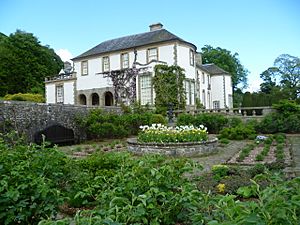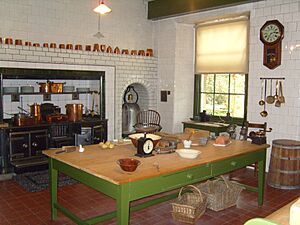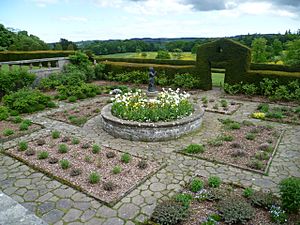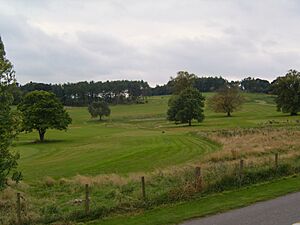Hill of Tarvit facts for kids
The Hill of Tarvit is a grand house and its gardens located in Fife, Scotland. It was designed by a famous architect named Sir Robert Lorimer in the early 1900s. Today, this amazing place is looked after by the National Trust for Scotland, and you can visit it!
Contents
Exploring Hill of Tarvit
This lovely house sits on a hillside about a mile and a half south of Cupar, a town in Fife. It has about 40 acres (which is about 160,000 square meters) of beautiful gardens and a much larger estate of 279 acres (about 1.1 square kilometers). This big area includes forests, open fields, farms, and wild heathland, offering amazing views all around.
Between 1905 and 1906, the house and gardens were completely redesigned for the Sharp family. Sir Robert Lorimer, a well-known Scottish architect, made it special. He included furniture in French and Chippendale styles, delicate porcelain, and many paintings that the Sharp family had collected.
Today, the National Trust for Scotland owns and manages the house and its large estate. They keep it just as Lorimer designed it, with the original furniture and decorations. Visitors can explore the house and see how the wealthy Sharp family lived. You can also peek into the "below-stairs" areas, like the kitchen, to imagine what life was like for the servants. There's even a 9-hole golf course that has been brought back to life. You can play golf there using old-fashioned hickory clubs and softer, rubber-wound balls, just like people did in the Edwardian era!
A Look Back in Time
The area where Hill of Tarvit stands has a very long history, going all the way back to the Iron Age. In 1946–1947, archaeologists dug up the remains of an ancient home at the top of Tarvit Hill. They found a large circular wooden house, about 17 meters across, inside an oval earth bank. It's believed people lived there between 200 BC and AD 200, and the house was rebuilt at least twice during that time.
Scotstarvit Tower
Around the year 1500, a building called Scotstarvit Tower was built about a mile southwest of where Hill of Tarvit is now. The Inglis family, who owned the land, built it as the main building for their estate. Later, in 1611, the tower was sold to Sir John Scott of Scotstarvit. Sir John rebuilt much of the tower in the 1620s. You can still see the date 1627 on a piece of the tower's old fireplace, which is now part of a fireplace in Hill of Tarvit's smoking room.
Wemyss Hall
The estate was once known as Unthank. After 1696, John Wemyss of Unthank changed it. He didn't use the old defensive tower anymore and built a new mansion house where the current Hill of Tarvit stands. He called this new house "Wemyss House." It's thought that the architect for this house might have been Sir William Bruce. Over the next centuries, the house grew, with extra parts added, especially in the 1840s. It was then largely rebuilt in 1907 by Robert Lorimer.
The Sharp Family and Hill of Tarvit
In 1904, a man named Frederick Bower Sharp bought Wemyss Hall and its large estate, which was about 1223 acres (about 4.9 square kilometers) at the time. The Sharp family had become very rich from the jute industry in Dundee, owning mills. Frederick also invested in other businesses, like railways. He wanted a new family home that was easy to get to from Dundee and close to his favorite golf course, Royal and Ancient Golf Club in St Andrews. He also needed a place big enough to display his huge collection of paintings, tapestries, furniture, and porcelain.
Even though Wemyss Hall was in a good spot, it wasn't big enough for Frederick's needs. So, he hired Sir Robert Lorimer, the same architect who had recently worked on Kellie Castle nearby. Over the next two years, the new mansion, which Frederick named Hill of Tarvit, replaced the main part of the old house. Some of the older service areas at the back were kept. The new house was very modern for its time, with electricity, an internal phone system, and central heating. In 1924, Frederick added a 9-hole golf course south of the house.
Frederick's wife, Beatrice White, was born in 1864. Her family was also wealthy from trading goods with America. Beatrice was very good at managing a household and entertaining guests, which helped make Hill of Tarvit a welcoming home.
Hugh Sharp, Frederick and Beatrice's only son, was born in 1897. He inherited the house when his father passed away in 1932. Hugh had served bravely in World War I and added to the house's collections. He was especially interested in rare books and plants, many of which you can still see in the gardens today. In 1937, Hugh was traveling by train to meet his fiancée when he was sadly killed in a train accident. His mother, Beatrice, continued to live at Hill of Tarvit until she died in 1946. Two years later, after his sister Elizabeth passed away, the house and the family's collections were given to the National Trust for Scotland, along with money to help take care of them. Hugh's collection of books was given to the National Library of Scotland.
For many years, until 1977, only the ground floor of the house was open to the public, and only if you made an appointment. The upper floors were used by the Marie Curie Foundation as a place for people to recover from illness.
The fireplace in the billiard room actually came from Scotstarvit Tower. Also, the monument at the top of Tarvit Hill used to be the market cross in Cupar. It was moved there after being won in a card game!






